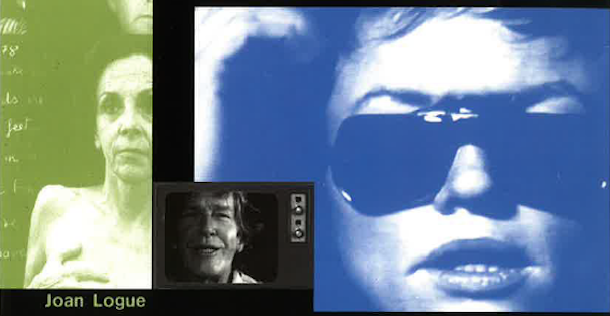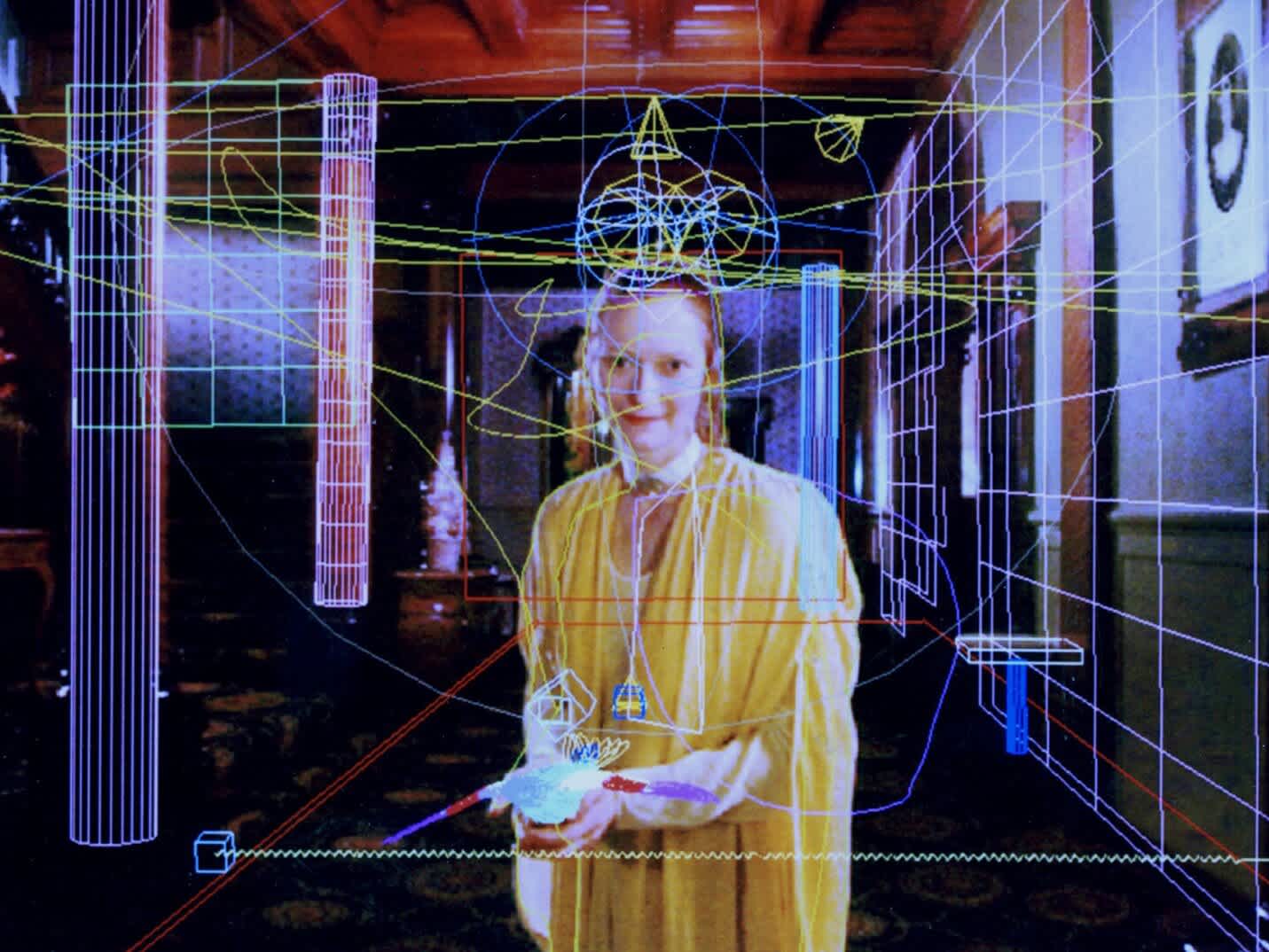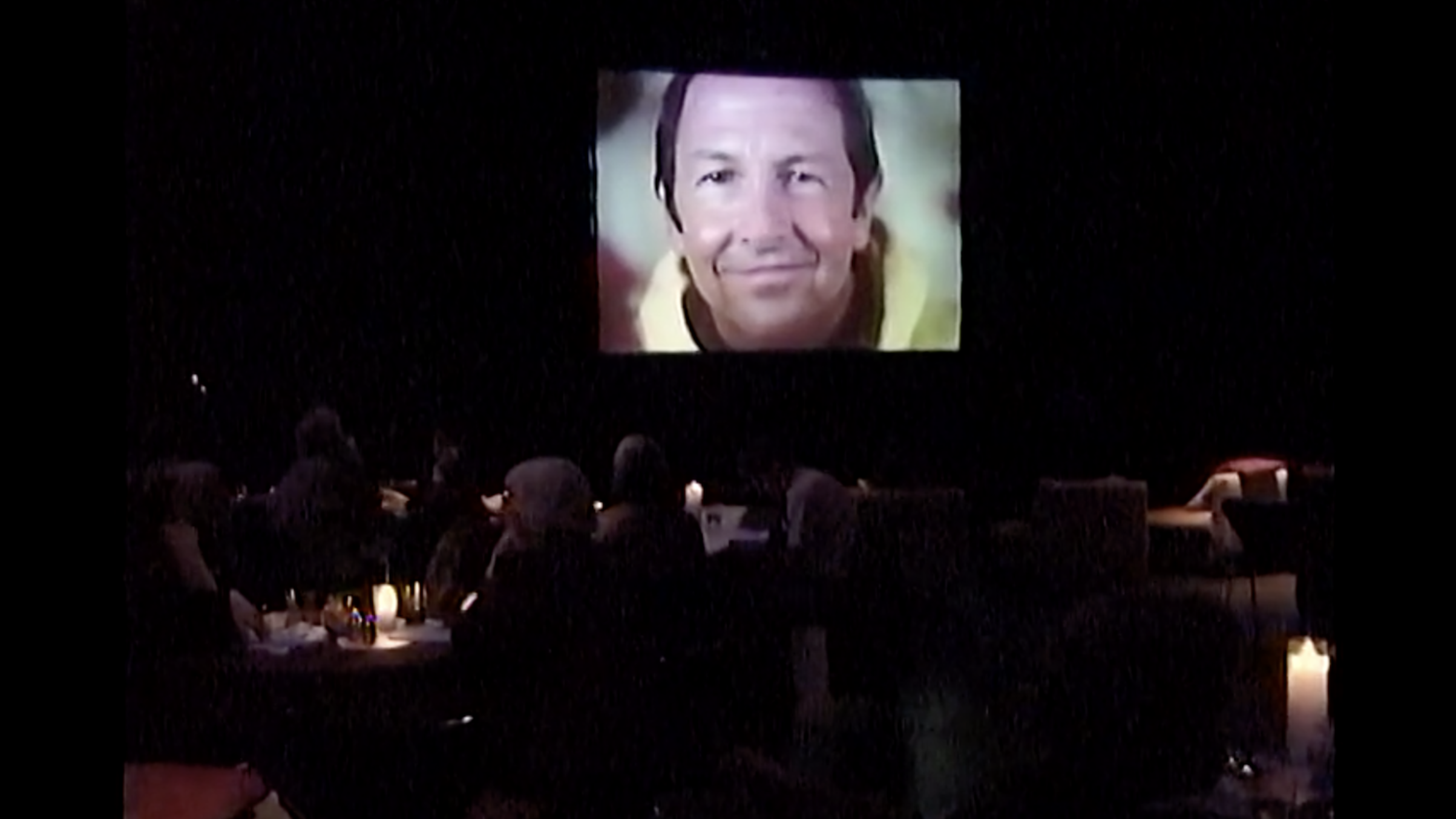
Credits:
By Kathy Cho, 2020–2021 Curatorial Fellow
April 19, 2022
“From the Archives” is a series that spotlights The Kitchen’s history. As a complement to our Archive Website, these posts offer focused reflections on the artists, exhibitions, events, and institutional practices that have defined and shaped The Kitchen since its founding in 1971.
FROM FALL 1998 TO WINTER 2004, The Kitchen regularly held a program called TV Dinner during which around forty attendees would gather to enjoy a vegetarian buffet and an evening of time-based art and conversation with featured participants—video artists, performers, musicians, dancers, curators, and more.
The TV Dinner series was the brainchild of Elise Bernhardt, The Kitchen’s Executive Director from 1998–2004, who approached her tenure with a focus on educating both herself and The Kitchen’s audiences on artists whose experimental practices were not well known outside of select communities.
In a recent interview, Bernhardt recalled how her performing arts background informed her work as she started her role at The Kitchen:
I didn’t know a lot about video art, so I needed to learn. I didn’t know who the artists were. I always figured, if I need to learn something, so do lots of other people.
I don’t want to change the art, but I want to give people a different way of understanding: what is it, who are these artists? They’re working with material on a level that most people are not comprehending, but there’s something really fascinating about what they’re interrogating. How do I peel the onion back and get to know the artists as people?
What makes artists so interesting and so compelling is that they have a vision. They have a line of questioning that nobody else has considered, and that’s what makes what they’re doing fascinating—and sometimes it fails. That’s the nature of experimenting. I think if you can reveal the process, then the audience doesn’t feel pushed out, they feel a connection. They are connected to the person. They’re connected to the inquiry.
With these initial ideas in mind, the inaugural TV Dinner featured a body of work called 30 Second Spots by Joan Logue, which The Kitchen’s program materials described as a ten-year long project comprising thirty-second “commercials” featuring artists from around the world.
THE EIGHTEEN ITERATIONS OF TV DINNER featured artists such as Lynn Hershman Leeson, Yoko Ono, Shirin Neshat, Miranda July, Barbara London, and Joan Jonas. During late-summer 2021, I learned more about the series through discussions with Bernhardt as well as with Anney Bonney and Christina Yang, two former curators who were directly involved in organizing various TV Dinners throughout their time at The Kitchen.
In my conversation with Bonney, Performance and Video Curator turned Media Director from 1997–1999, she described TV Dinner as “a curated, editorialized way of honoring equally our historical past and evolving present. We wanted to highlight people who had been such important artists at The Kitchen. Their careers clearly deserved acknowledgement.” During the ’90s and early 2000s, Bonney says, “The Kitchen was at a crossroads. Looking back from 2022, the TV Dinner era was The Kitchen’s timeline midpoint. The question of support was unavoidable. It was obvious, here’s this amazing art space in Chelsea, ahead of its time; but now, what about its future? How is it going to survive? Like so many museums, we understood we’d have to expand our audiences and attract new people, to take a different kind of risk.” Bernhardt’s self-described interest in educating both herself and The Kitchen’s audience and Bonney’s institutional contextualization of the series indicate how TV Dinner sought to close the gaps in how audiences understood the practices of experimental artists.
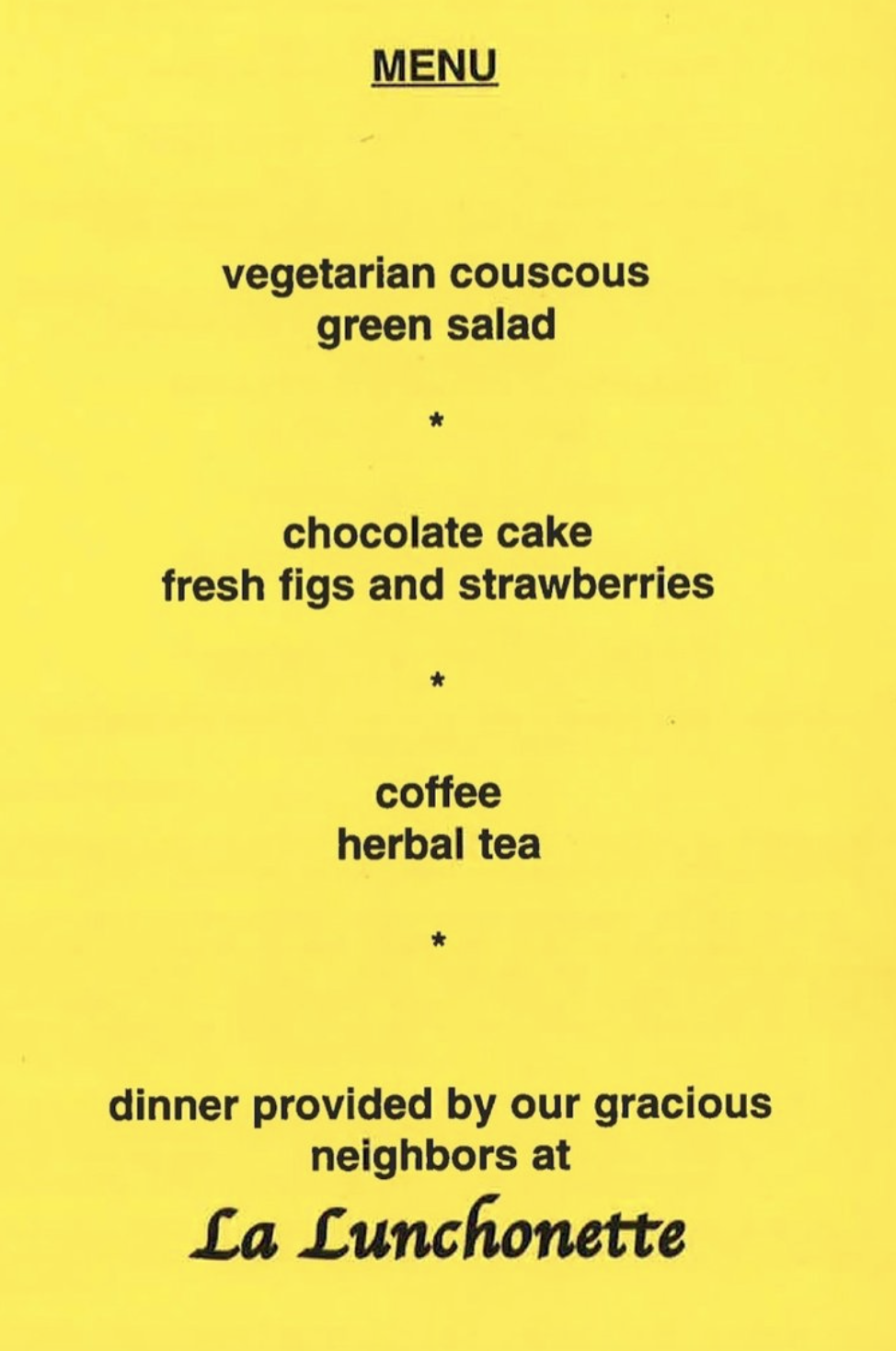
Throughout the yearslong programming of TV Dinner, the food was catered by La Luncheonette, whose owners organically became good friends of The Kitchen due to its proximity one block away on 10th Avenue at 18th Street (the restaurant shuttered in 2015). The meals provided during TV Dinner—always vegetarian and served buffet style, usually with some wine to go along—were a foundation for bringing people together. The aura of the event was semi-casual, with black table cloths covering round silver tables with flowers in the middle, usually seating around eight people at a table. The menu contents were not at the forefront of the event: artists typically did not collaborate on devising them, as we might anticipate artists contributing to designing dishes or signature cocktails for programs today.
Bernhardt describes the attendees at the beginning of the TV Dinner series as people who were already familiar with The Kitchen but who wanted to learn more about the featured artists and be engaged in a different way. As the series progressed, previous attendees helped to bring in new audiences by word of mouth. Other audience members came because they were interested in one of the speakers, or the featured artist.
According to Bernhardt, there was a sense of nostalgia in reviving the concept of TV dinners that was popularized in the early ’50s. The format of the event gave an excuse to chat with your neighbor, and it was likened to “dinner with a show.” Additionally, I imagine that the nostalgia factor and informal dinner format gave the evenings a sense of intimacy that may have made them more inviting than attending an artist lecture or performance alone.
Christina Yang—The Kitchen’s Media Director turned Visual Art/New Media Curator from 1999–2004—began organizing TV Dinners after Bonney, beginning in the fall of 1999. She describes the series as such: “the original idea was [to platform] video artists or artists working in video and performance. But it ended up being, for me, tied more to the artist I was exhibiting in the gallery. And the gallery did typically show either new media, digital, or video artists… It became an artist talk dinner series... And it was fun. I think we almost always sold out.”
Another layer of social affinity within the TV Dinners came from the relationships and familiarity between the chosen speakers. As Yang notes:
Each TV Dinner was very special. The artists that were involved were always really good speakers. I remember Charlie Atlas in conversation with Lucy Sexton very vividly. I remember Miranda July and Barbara London went into her stage set to do her talk. And the very first question was, “Miranda, did you ever run away from home?” It was a very relaxed setting that allowed comfortable conversation. And usually the moderators were really close to the artists and had done a lot of prep.
[For example] Barbara spent quite a bit of time studying Miranda’s work and came to some of her performances. Lucy is a longtime friend of Charlie’s, and she also had her own quasi-television show. So she kind of modeled on that. They were both in interview and interviewee mode, even though they’re very good friends.
Some of them were a little bit more formal, like the Elizabeth Zimmer and Lucinda Childs one. We really made an effort to have the moderator have as much of an audience, or draw, as the artist themselves. The program followed a pretty set kind of timetable and had its own choreography. It was a nice way to have the audience have a role, even though they were eating and serving themselves.
Both Yang and Bonney affirm that there was room to shape the TV Dinners depending on who they invited to present their work or to be in conversation with the artists. Variations on the event format allowed for artists to share films, performances, dances, and other time-based media and for audiences to experience and digest these works in a group setting.
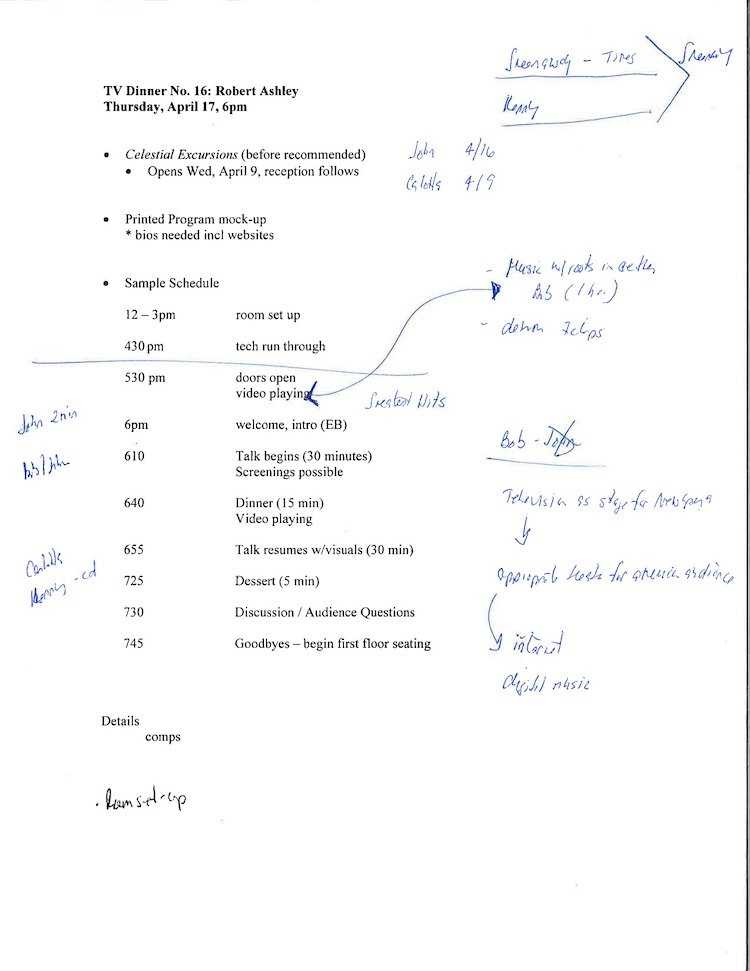
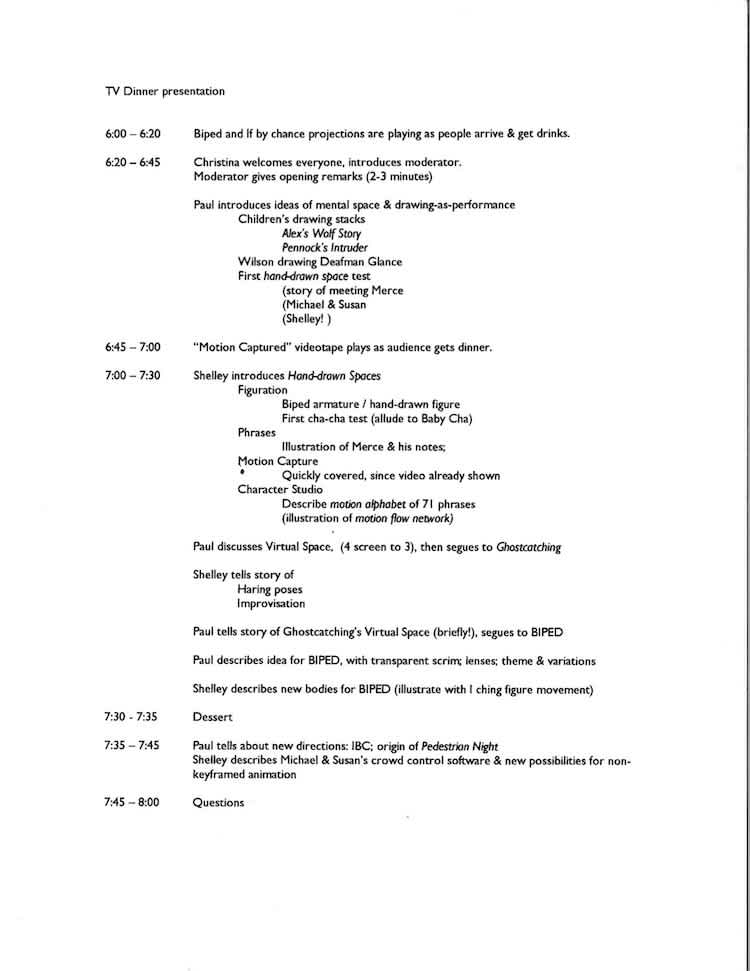
THE SERIES EVOLVED OVER TIME as it became a more established event that would happen at least once a season. At first the press materials introducing TV Dinner to the public stated that the event “invites groundbreaking video (or electronic) artists to show their work and share their thoughts in the informal atmosphere of The Kitchen’s second floor theater. The audience meets the artists over video screenings and a dinner provided by a neighborhood restaurant.” As the event came into its own, the language shifted: by 2002, materials named TV Dinner as one of The Kitchen’s “signature programs that pioneer new forms of public engagement in visual art, new media, and performance; choreographed around a vegetarian meal and followed by a live performance.”
Yang mentions that in this time “twenty-some-years ago, it wasn’t always a given that exhibitions would have a public program that would feature an artist. You would just focus on the artwork and not involve the creator. The idea that you curate accompanying programs was probably newer then.” In the past, especially in larger institutions, exhibition-related programming or events giving the audience access to the artist’s intentions and process were more commonly siloed into the realm of education. Today, programming increasingly blurs boundaries—drawing on a more collaborative approach with artists, educators, curators, and administrators—to provide audiences with context for an exhibition or event through even more tailored variations of performative-lecture formats and events with food, much like TV Dinner.
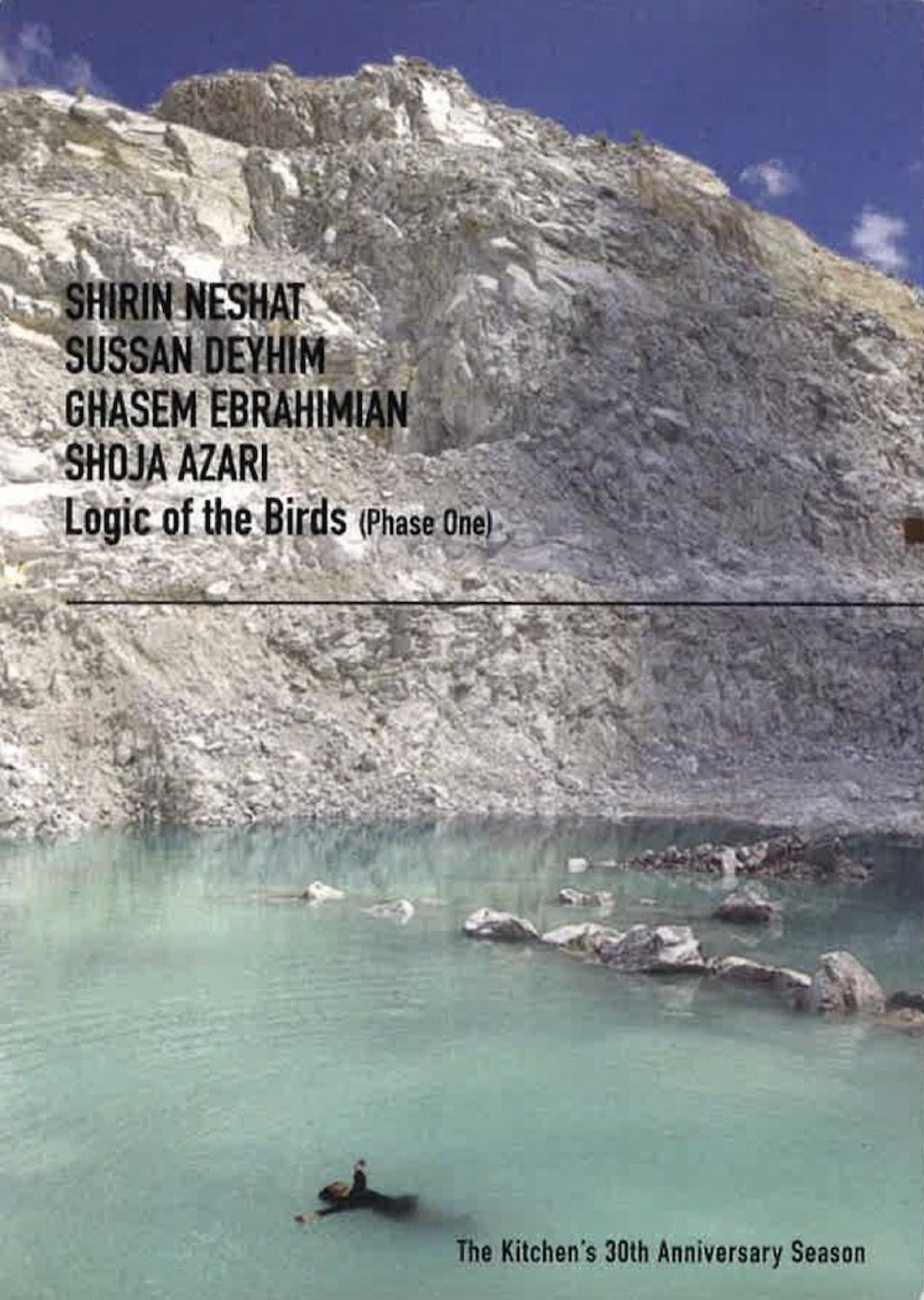
The TV Dinner series seems to have acted as a marker of its time, while also demonstrating its adaptability. For instance, in the immediate aftermath of 9/11, The Kitchen decided not to cancel Logic of the Birds, an exhibition of film, music, and live performance recontextualizing an ancient Persian parable The Conference of the Birds through the lens of a Persian femme mythology. The exhibition included works by interdisciplinary artists and filmmakers Shoja Azari, Sussan Deyhim, Ghasem Ebrahimian, Shahram Karimi, and Shirin Neshat. Neshat, Deyhim, Ebrahimian, and Azari also collaborated on a performance-film piece, also titled Logic of the Birds, which was scheduled to run the first two weeks in October 2001, and be the focus of the TV Dinner moderated by guest curator Roselee Goldberg.
According to a New York Times article by filmmaker Amei Wallach, published in late September 2001, the group of artists and guest curator Roselee Goldberg had been collaborating on the exhibition and performance-film for about a year. After 9/11, The Kitchen initially decided to postpone the event indefinitely, but as Wallach noted, “by the next Monday, however, Sept. 17, it seemed more essential than ever for this contemporary rendition of a central text of Iranian culture to go on.” In the article, Azari says, “we came up with the determination that it is even more important than before to represent the beauty of a culture. Evil doesn[t know sides. Creativity and terror, construction and destruction, this is the condition of human nature. So let’s create.” Ultimately, “TV Dinner: Logic of the Birds” took place the evening of October 11, 2001, during the run of the multimedia presentation of Logic of the Birds from October 5–16, 2001.
Yang notes that the series “fit this interesting niche of social education and a different kind of performance than a dramatic stage performance. So was it The Kitchen’s curatorial attempt at a kind of social practice or lecture performance? It wasn’t, because it was dinner and a talk. It was a kind of in-between space. I remember it as being very comfortable. It felt like a special public program, because the choreography for dinner was so formalized.”
The series eventually led to an organic offshoot called TV Dinner Dance (February 2001–May 2002), a collaboration informed by a budding friendship between Yang and then Dance Curator Dean Moss, who worked at The Kitchen from 1999–2004. One event in this focused series, “TV Dinner: Dance No. 3 Celebrating the Legacy of Lucinda Childs,” was part of a three-week retrospective of Childs’s thirty years of work, presented in April 2002. The program was an opportunity for attendees to gain insight into the artist’s decades-long career, with screenings of multiple performances and interviews with collaborators, close friends, and experts in her field about her oeuvre. Although Childs was not in attendance at the TV Dinner, Bernhardt acted as moderator in conversation with Susan Sontag and Philip Glass, yielding what I imagine was a lively discussion about Childs’s legacy and contribution to dance.
The TV Dinner format additionally generated an external collaboration with the art organization Rhizome called Digital Happy Hour (2000–2004). This monthly event focused on new media artists and those interested in the scholarship around new media.
IT IS DIFFICULT TO QUANTIFY THE IMPACT that TV Dinner may have had within the New York art ecosystem and beyond. What can be said, though, is that the TV Dinner series is reflective of a six-year period in the late 1990s and early 2000s during which The Kitchen started initiatives with the aim of introducing audiences to experimental artists. Over this time, and with the contribution of various collaborators, these programs evolved into a generous platform that enriched collective knowledge practices across the field of experimental mediums.
CONTRIBUTOR BIO
Kathy Cho (she/they) is a curator who produces exhibitions, events, images, and writing to collectively archive loose narratives of lived-experiences, care, and feminism(s). Ongoing research includes expanding the visual and dialogic lexicon of Asian diaspora artists, and exploring the physical and digital architectures of affect.
Quotations from Elise Bernhardt, Anney Bonney, and Christina Yang are drawn from interviews conducted by the author in August and September 2021.

